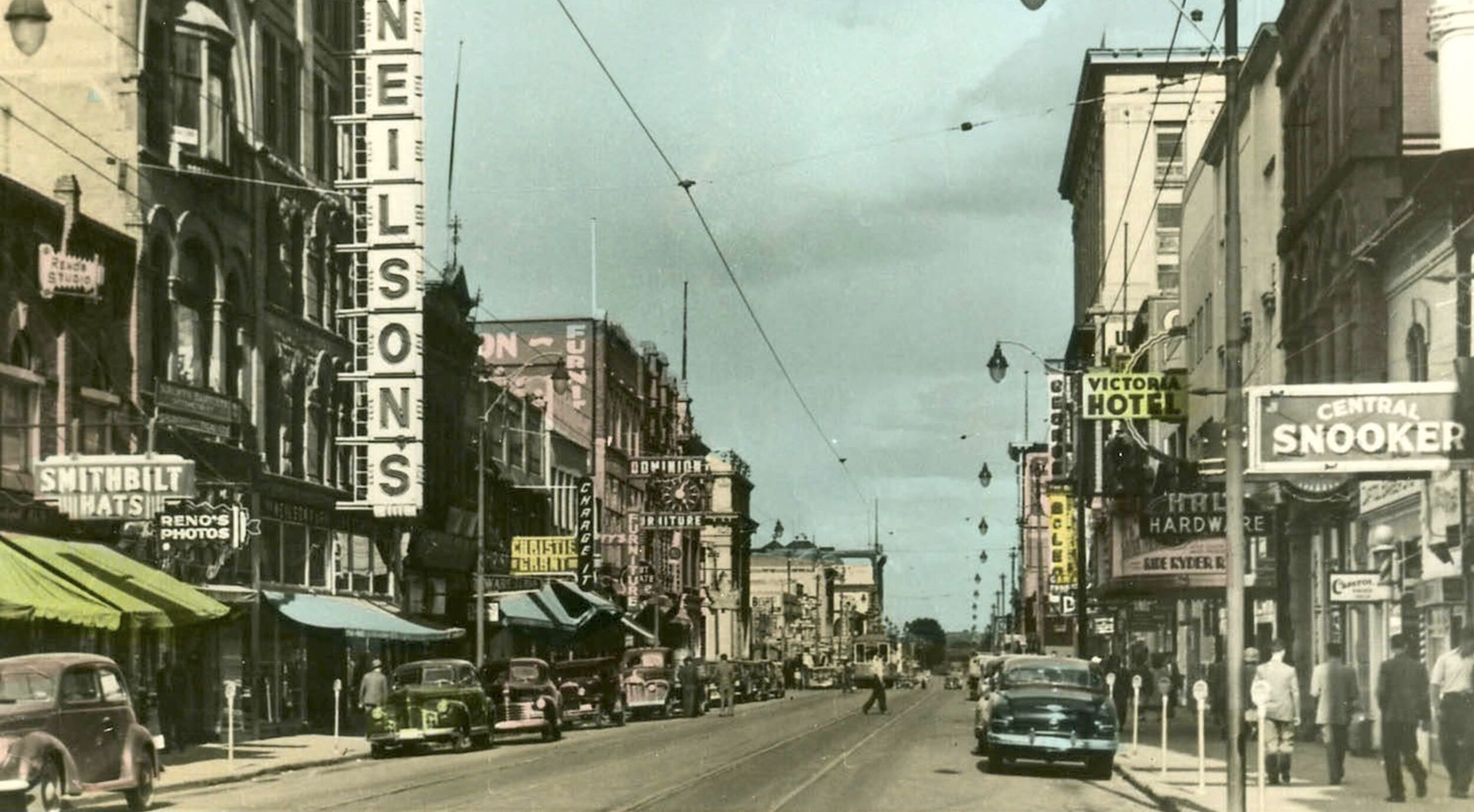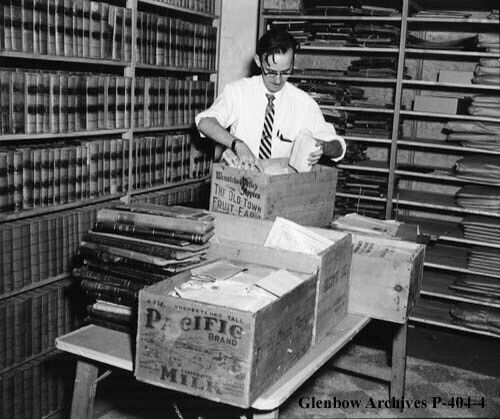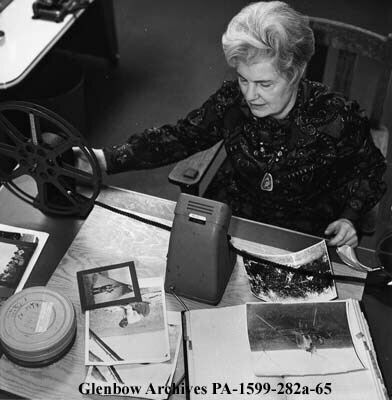
This stretch of Stephen Ave. was demolished to make way for the new Glenbow Museum and convention centre in the 1970s. Photo (undated): Calgary Public Library
Erosion of home: The loss of the Glenbow Archives
Stowing away our past.
For over 50 years, the Glenbow museum has been a cornerstone in Calgary’s cultural community.
It is where Calgarians and visitors to our city have come to learn about this place, share our stories and interpret our past.
Glenbow was founded in 1954 by oilman Eric Harvie, a collector of historical and cultural objects from Western Canada and around the world. Harvie made his fortune almost overnight when the Leduc No. 1 well struck oil in 1947, after which he dedicated his life to oil exploration, philanthropy and building his eclectic collection.
In 1966, Harvie donated his collection to the people of Alberta, formally creating the Glenbow-Alberta Institute (now the Glenbow Museum). The archives and collections still belong to the people of Alberta, and Glenbow provides care and access to these diverse collections.
These include an Indigenous studies collection, an extensive local community history collection, historical and contemporary art, and a library and archives.
But last fall, Glenbow announced that it would be relocating its archival holdings, through a long-term loan, to the University of Calgary, closing the Glenbow Library and Archives downtown.
Glenbow has always been a strange beast — a museum, art gallery, library and archives, all rolled into one.
Donna Livingstone, Glenbow’s recently departed president and CEO, explained that the move would free up "valuable storage and potential exhibition space as we continue to build our collection to reflect a focus on art and artists."
The library and archives include some 22 million pages of textual records, two million photographs, 15,000 maps and much more—making it Canada's largest non-governmental archival repository.
Until recently, the reading room on Glenbow’s sixth floor served as a major research centre for research for historians, writers and other researchers.

When the move was announced, university staff marketed the opportunities of the new Glenbow Western Research Centre. They spoke of increased accessibility for students through the storefront location in the Taylor Family Digital Library. They lauded the controlled environmental conditions at the university, which will maintain humidity and temperature to aid in preservation.
However, many local researchers are worried about the loss of the Glenbow reading room, the accessibility of the collection for the community, and the loss of institutional knowledge of the archival material—and what it will mean to our civic identity.
From downtown to the city's edge
Current accessibility at the university library leaves much to be desired. The bulk of the archival collection, including the newly-acquired Glenbow material, is stored off-site at the high-density library at Spy Hill on the outskirts of the city.
This means that researchers will need to request material days before their visit, or they will only have access to the materials that happen to be in the storefront location that day.
Archival collections are not neutral. How they are collected, catalogued, stored, and made accessible impacts how the collection is perceived and interpreted. The storage system at the university privileges certain records over others.
This means that select records are made more accessible for researchers, which in turn impacts the research that occurs—and the production of knowledge from that research.
Where researchers once had access to the archives, now they have a bureaucratic process that stymies research.
Previously, in Glenbow’s reading room, staff could retrieve archival and library materials in a matter of minutes.
This facilitated one of the best things about archival research: the sense of discovery that can happen when one record creates unexpected leads. A reference to a previously unknown person, place, or event, can connect to another set of records and a new line of inquiry.
Spontaneity, and the possibility of serendipitous finds, are potentially lost in the move to the university.
Where researchers once had access to the archives, now they have a bureaucratic process that stymies research. Unencumbered access to following leads is foundational to good research.
Losing capacity to tell local stories
In addition to the collection, the strength of any archive is found in the staff.
Glenbow has a rich history of competent and knowledgeable staff. And this vital component of the collection is not following the archives to the university, including archivists, librarians and longtime director Doug Cass, who knows the Glenbow collection intimately.
Any researcher will tell you that a good archivist who knows the collection is as good a resource as the best finding aid or catalogue. It’s not possible to properly transfer this institutional knowledge without the people that hold it.

The loss of the archives will fundamentally affect the rest of Glenbow, too. Glenbow has always been a strange beast—a museum, art gallery, library and archives, all rolled into one. Historically, one of the benefits of Glenbow’s unique model was that the different collections could speak to each other.
For example, Glenbow has a vast community history collection about the lives of southern Albertans in all their diversity. This collection includes objects related to domesticity, work, play, and other aspects of social and cultural life. The archival collection has complemented this, as it provides valuable information on the communities, their objects, makers and users.
All told, Glenbow is opting to lose a pillar of its capacity to tell stories.
Some of Glenbow’s strongest exhibits have been those that pull from several of its collections at once. These include projects like The Arctic: Real and Imagined Views from the Nineteenth Century, an exhibit that combined artworks and artifacts from the collection with archival material like books, prints, and periodicals to provide the necessary context.
This is Glenbow’s strength and what separates it from other institutions with similar mandates.
What else are we losing?
The transfer of the archives is paired with a new vision for Glenbow Museum to become “Calgary’s art museum.” Initially, this vision seemed to include space for not just contemporary art, but also cultural and historical expertise, as well as highlighting the importance of the diverse non-art collections.
Allowing for the intersections of art, artifacts, and archives seemed to be a new kind of art museum that Glenbow could make possible.
Unfortunately, in the last several years, the core of staff responsible for caring for, maintaining, and interpreting the collections and archives has been slowly dismantled.
Calgarians are hungry to learn more about their city, to learn the diversity of stories and people that make this place.
Many curatorial roles have been left vacant for several years. And much of the staff working directly with the collection have had their hours cut or their positions eliminated.
What else are we losing in Glenbow’s re-envisioning of itself?
Calgarians are hungry to learn more about their city, to learn the diversity of stories and people that make this place. The transfer of the Glenbow Library and Archives is just the latest step in the erosion of what was once a home for Calgary’s history.
Our community is lesser because of it.
Caroline Loewen is a Calgary curator and writer. Her curatorial practice focuses on exploring ideas around cultural geography, place-making, memory and cultural/natural landscapes.
The Sprawl is crowdfunded, ad-free and made in Calgary. Please consider supporting independent journalism. Become a Sprawl member today!
Support in-depth Calgary journalism.
Sign Me Up!We connect Calgarians with their city through in-depth, curiosity-driven journalism—but can't do this alone! We rely on our readers and listeners to fund our work. Join us by becoming a Sprawl member today!
